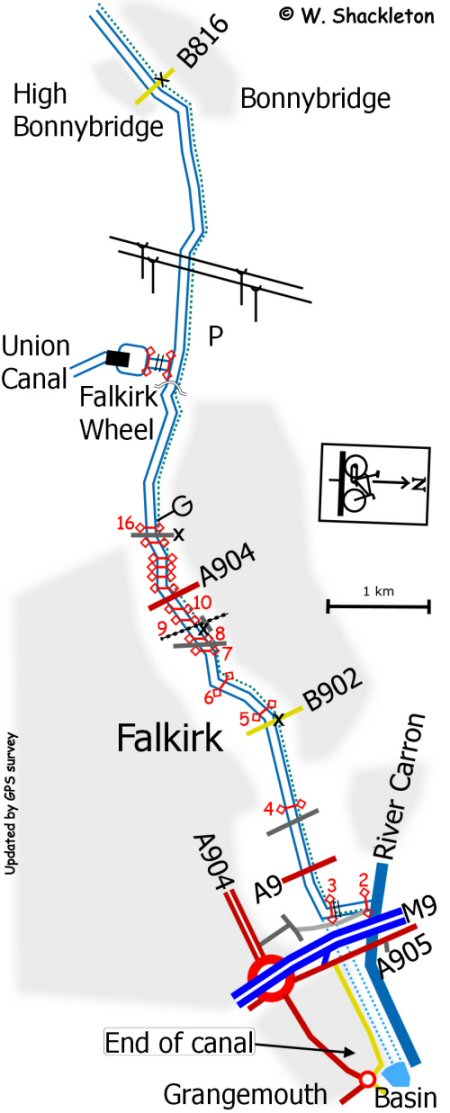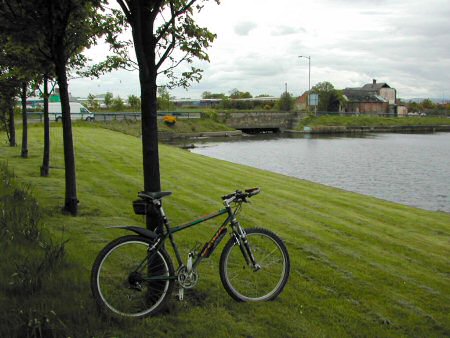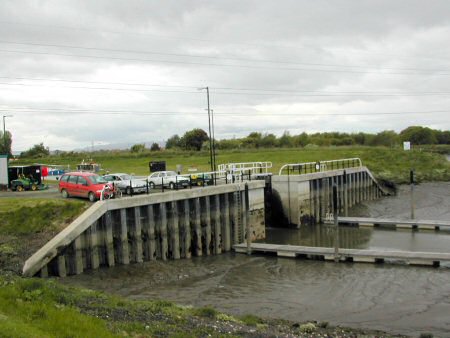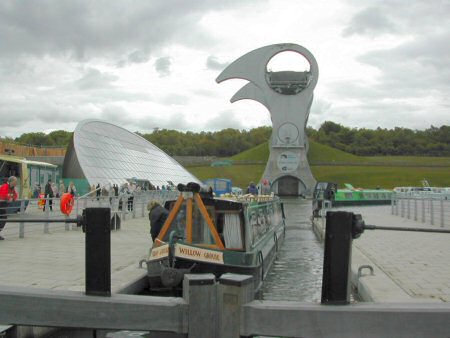
Part 1 Grangemouth to Bonnybridge
The Forth & Clyde Canal is not a cycle route as such, cycling is tolerated on the canal towpath when the cyclist is in possession of a permit from British Waterways. That’s the official line, though I would very much doubt if British Waterways has ever asked anyone for a permit.
This review of the canal journey from Grangemouth to Bowling is broken down into seven parts for easy reference

The Forth & Clyde Canal revolutionised transport in Scotland. No longer would small loads, destined for Edinburgh of Glasgow be loaded onto pack horses, now tons of cargo could be loaded onto barges and be there the day after tomorrow!
The canals fortunes turned with the arrival of the railways, now your goods could be there on the same day, the canal lingered on until its death knell in the 1960's; the old to Stirling needed upgrading, so rather than incur extra xpense in building a bridge for an unused canal the engineers simply made a culvert, and the canal was closed. Later the M9 came on the scene, which took care of the first two locks at the Grangemouth end and the orphaned portion of the canal was filled in for housing.

Grangemouth basin. The low bridge is all that remains of the original canal.
Thirty years later, it was decided to re-open the canal, money had become available from the Millennium Commission to re-open the canal a whole new section had to be re-dug.

The sea locks at the River Carron.
Now, instead of opening out into a series of sea-locks, the canal opens out into the River Carron, which is tidal, with a large variation in tide heights.
The start to the canal is hidden behind a distribution warehouse, which is buried within an industrial estate. Assuming that you can find your way through the industrial estate, to find the very low key approach road to the first of the new locks. The thought crossed my mind that there was a large sum of money spent on re-opening the canal and they could not even tar the road to the first lock.
From the first lock, which incidentally is numbered lock 2, you need only ever cross the canal three times in the entire journey from Grangemouth to Bowing. The first crossing is just before lock 3 the path continues along the north side of the canal, all the way to Maryhill in Glasgow.
The way is approximately flat until lock 6, when the canal climbs up to lock 16 at Camelon in Falkirk. A detour has to be made between locks 8 and 9, the footpath used to go straight over a railway line and now the route had been barred with a security fence. It is only a matter of climbing up a flight of stairs, cross a road bridge and down another flight to re-join the foot path.
At lock 16, you will have to negotiate a busy roundabout right beside the canal, then you will meet the first of many path access gates. I guarantee that by the time you reach Bowling that you will be thoroughly sick of these gates. It works out that there is a gate for every mile of canal, though they are mainly concentrated in Glasgow.
The Union Canal, from Edinburgh joined the Forth & Clyde at Port Downie by lock 16, the junction and the connecting locks were filled in and built on, which meant that when the money became available to re-open the Union Canal a rather spectacular engineering solution had to be devised, which you will see a short distance from lock 16 – The Falkirk Wheel.

Falkirk Wheel
The wheel has two sections of canal, the upper one at the level of the Union Canal and the lower one at the level of the Forth & Clyde Canal. A boat enters the wheel and the entire wheel rotates, lowering the boat to the level of the Forth & Clyde or raising it to the level of the Union. Visitors can enjoy the process by riding on pleasure barges, though they are heavily booked in advance.
If you need a sign of the canals regeneration then look no further than the Falkirk Wheel which is built upon the site of a tar works. Much effort went into making this site safe as it and the canal was heavily polluted by toxic and base metals, waste from many years of tar refining.
You pass by the Wheel and head out into the countryside before entering High Bonnybridge and perhaps the worst road crossing of the trip. I found it very difficult to cross this simple B class road due to the high volume of lorries on the road.
After the crossing have a peek into the scrap merchants yard, I saw a small and a large traction engine when I passed.